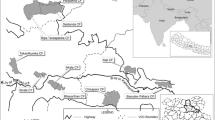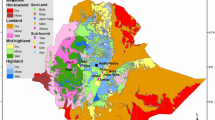Abstract
Because trees cover only 6.4% of the total land area of Bangladesh, while agricultural expansion continues to massively deplete the natural forests, a well-managed homestead forestry practice is vital for reversing the existing trend and promoting the ecological balance of the country. An understanding of the decision-making process of the farmers who practice homestead forestry is important in expanding and improving the practice. This paper seeks to characterize and analyze factors influencing farmers' decisions about tree planting. Logistic and multiple regression analyses were applied to determine the factors that influence the farmers' tree-planting decisions. The analyses demonstrate a number of important conclusions: (i) tree-planting increases with the amount of homestead land owned; (ii) farmers whose main source of income is non-agricultural are more likely to decide to plant trees in the homestead; (iii) purchasing cost of fuelwood has a positive influence on tree-planting decisions; (iv) number of male family member has a positive influence on farmers' tree-planting decisions; and (v) knowledge of the activities of the forestry extension programs has a positive influence on tree-planting decisions. The results of the study demonstrate that, in recent years, farmers' decisions of whether or not to plant trees have been based primarily on economic rather than ecological concerns. It is concluded that there is substantial potential for the improvement of homestead forestry, and that properly managed homestead forestry can alleviate the poverty of rural people by increasing overall household income. To this end, it is suggested that forestry extension workers work more closely with the local people in order to implement homestead forestry.
Similar content being viewed by others
References
Arnold JEM (1987) Economic considerations in agroforestry. In: Steppler HA and Nair PKR (eds) Agroforestry: A Decade of Development, pp 173–190. ICRAF, Nairobi, Kenya
Besley T and Case A (1993) Modeling technology adoption in developing countries. Am Econ Rev 83: 396–402
Bishop KD (1992) Britain's new forests: public dependence on private interests? In: Gilg AW (ed.) Restructuring the Countryside: Environmental Policy in Practice. Avebury Studies Green Research, 146 pp
Dembner SA (1987) Forest sector planning in Bangladesh. Forestry Project Profiles No. 3, FAO Forestry Department, Rome
Dewees PA (1992) Social and Economic Incentives for Smallholder Tree Growing: A Case Study from Muranga District, Kenya. Community Forestry Case Study Series No. 5. FAO, Rome, Italy
FAO (1995) Forestry Statistics Today for Tomorrow. Food and Agriculture Organization of the United Nations, Rome, Italy
FAO (1989) Forestry and food security. FAO forestry paper 90, Food and Agriculture Organization of the United Nations, Rome
FAO (1985) Tree growing by rural people. Food and Agriculture Organization of the United Nations, Rome
FAO (1978) Forestry for local community development. FAO Forestry Paper 7. Food and Agriculture Organization of the United Nations, Rome, Italy
Francis PA and Atta-Krah AN (1989) Sociological and ecological factors in technology adoption: fodder trees in southeast Nigeria. Exp Agric 25: 1–10
Giri C and Shrestha S (1996) Land cover mapping and monitoring from NOAA AVHRR data in Bangladesh. International Journal of Remote Sensing 14: 2749–2759
Godoy R (1992) Determinants of smallholder commercial tree cultivation. World Development 20: 713–725
Gregerson H, Draper S and Elz D (eds) (1989) People and Trees: The Role of social Forestry in Sustainable Development. EDI Seminar Series. The World Bank, Washington DC
Hocking D, Sarwar G and Yousuf SA (1997) Trees on farms in Bangladesh: 4. Crop yields underneath traditionally managed mature trees. Agroforestry Systems 35: 1–13
Hocking D, Hocking A and Islam K (1996) Trees on farms in Bangladesh: 3. Farmers' species preferences for homestead trees, survival of new tree planting, and main causes of tree death. Agroforestry Systems 33: 231–247
Hocking D and Islam K (1994) Trees in Bangladesh paddy fields and homesteads: participatory action research towards a model design. Agroforestry Systems, 25: 193–216
Hyman EL (1983) Loan financing of smallholder tree farming in the provinces of Ilocos Norte and Ilocos Sur, Philipppines. Agroforestry Systems 1: 225–243
Imam MH (1991) Social forestry perspective and Bangladesh. Asian Profile 19(2): 185–192
Johnston J and Dinardo J (1997) Economietric Methods. The McGraw-Hill Companies, Inc., pp 424–426
Leuschner WA and Khaleque K (1987) Homestead agroforestry in Bangladesh. Agroforestry Systems 5: 139–151
Levy PS and Lemeshow S (1991) Sampling of populations: methods and applications. John Wiley & Sons, Inc., 18 pp
Malla YB (1997) Sustainable Use of Communal Forests in Nepal. Journal of World Forest Resource Management 8: 51–74
National Academy of Science (NAS). 1980. Firewood crops: shrub and tree species for energy production. NAS, Washington, DC, USA
Shiva V, Bandyopadhyay J and Jayal ND (1985) Afforestation in India: problems and strategies. Ambio 14: 329–333
Singh K and Balooni K (1995) Tree Growers' Cooperatives: Farm Forestry in India. Journal of Forestry 95(10): 32–35
Smit B and Smithers J (1992) Adoption of soil conservation practices: an empirical analysis in Ontario, Canada. Land Degradation and Rehabilitation 3: 1–14
Thacher T, Lee DR and Schelhas JW (1997) Farmer participation in reforestation incentive programs in Costa Rica. Agroforestry Systems 35: 269–289
Thaman RR and Clarke WC (1993) Pacific Island agroforestry: Functional and utilitarian diversity. In: Clarke WC and Thaman RR (eds) Agroforestry in the Pacific Islands: Systems for Sustainability, pp 17–33. United Nations University Press, Tokyo, Japan
Author information
Authors and Affiliations
Rights and permissions
About this article
Cite this article
Salam, M.A., Noguchi, T. & Koike, M. Understanding why farmers plant trees in the homestead agroforestry in Bangladesh. Agroforestry Systems 50, 77–93 (2000). https://doi.org/10.1023/A:1006403101782
Issue Date:
DOI: https://doi.org/10.1023/A:1006403101782




